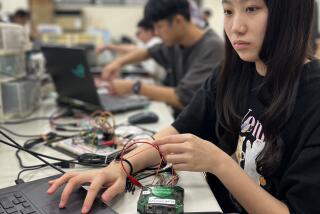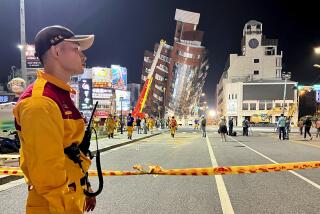U.S. Tech Firm Retools to Survive the Asian Threat
The daily production meeting at Electronic Source Co. feels like an air traffic control operation.
One by one, managers fire off questions. Where is that key component for next weekâs big order? Can we deliver on that three-day deadline for the anti-skid braking system?
Before the meeting breaks up, the managers run through their to-do lists. Those who fail to complete their âaccountablesâ -- including President Scott Alyn -- are asked to explain why.
âThey hold my feet to the fire,â Alyn, 41, said of his six-person management team. âWe believe in 360-degree accountability.â
After coming close to collapse in 2001, ESC is inching back to profitability, one order at a time. This year the small Van Nuys firm expects to post $3 million in revenue, matching sales near its peak in 2000. Many others in the U.S. printed circuit board industry have fallen under the collapse of the technology bubble and the migration of manufacturing to China and other lower-cost Asian countries.
But ESC offers one route for surviving the Chinese threat: by being nimble and targeting markets such as the military that are more likely to buy American.
Alyn has carved out a niche assembling customized circuit boards for customers willing to pay a premium for quick turnaround, quality and reliability. His customers in the defense industry, including Raytheon Co. and a subcontractor for Boeing Space and Intelligence Systems, install his boards in jet fighters and military satellites.
A printed circuit board is a piece of insulated material that becomes a conduit for electricity when electronic components, such as chips, are attached. Circuit boards are used to power cellphones, computers, automobiles and airplanes.
Keeping firms like Electronic Source in business is a growing concern of the U.S. military, which depends on private businesses to develop and produce the bulk of its hardware. In the last two decades, the bulk of that manufacturing has gone overseas, lured by cheap labor and exploding markets.
The U.S. share of global revenue from production of printed circuit boards is projected to be less than 10% in 2006, compared with 42% in 1984, according to a report by the National Research Council of the National Academies in Washington. The report raised an alarm about the decline of Americaâs manufacturing capabilities.
Last year China surpassed the U.S. as the leading exporter of information and communications technology, according to a report issued this week by the Organization for Economic Cooperation and Development. China exported $180 billion of high-tech goods, compared with $149 billion for the U.S.
This shift in technology production has left the military increasingly dependent on foreign suppliers for key components such as circuit boards. That could leave the U.S. vulnerable to sabotage or a cutoff in supply if key producers are in countries that are not dependable U.S. allies, according to the National Research Council study.
Among the reportâs recommendations: that the Defense Department consider investing in circuit board design and manufacturing technology and building a domestic network of shops that can be âtrusted to manufacture [circuit boards] for secure defense systems.â
Alyn started his company in 1994 with a $30,000 loan from his parents. By 2000, ESC was riding the telecom boom and sales were expanding by 80% a year thanks to orders from three large telecommunications firms. But by May 2001, Alynâs orders had fallen by more than 40% and he was forced to lay off all but 15 members of his staff. There were days when he and his receptionist were the only ones in the plant.
âBut I had had a taste of success,â said Alyn, who holds an MBA from USC and is the son of a technology entrepreneur. âI just had to keep reminding myself this was a cycle, and ... it was industrywide. If it wasnât for those things, I might have just thrown in the towel.â
For Alyn, the mantra of survival was diversification. His firm received a special certification that allowed him to supply top-tier defense and aerospace companies. He also began developing customers in the automotive and healthcare fields. One client builds a diesel engine enhancer, another a testing device for cataracts.
âIf defense cutbacks come into play again, weâve still got aviation, medical, telecom and industrial,â Alyn said.
But as the market for circuit boards began to turn around, Alyn began running into factories from China that were underbidding him by as much as 20%.
Alyn couldnât come close to matching the China price on labor-intensive goods. Assembly workers at ESC start out at about $7.50 an hour; factory workers in China are paid less than $1 an hour. Even if a Chinese manufacturer couldnât match ESCâs quality, it could afford to have a large crew repairing boards by hand.
Alyn invested $500,000 in an automated assembly machine that can place chips smaller than a speck of pepper onto circuit boards at a dizzying rate of 53,000 an hour. One board might contain as many as 2,500 parts.
Speed became Alynâs biggest competitive advantage. Even the fastest Chinese factory couldnât produce and air-freight an order to a customer in California in less than a week. By using the new machine and three shifts of workers, ESC, which employs about 65 people, could complete an order in less than 24 hours.
Although foreign competition has kept prices low, the cost of energy and raw materials continues to rise. The price of solder, a key component, has nearly doubled in the last year.
Rewarding performance pays off, Alyn says. He provides a monthly bonus to everyone, including the line workers, if the company does well on its customer ratings. He said those bonuses, which amount to about 10% of gross revenue, were given out about half the time. âWe get everyone focused,â he said.
But this year Alyn decided he needed help navigating the global marketplace. At the advice of a friend, he hired Rich Chrono, a business coach, to serve as his âunofficial board of directors.â He meets with Chrono once a week.
Chrono, a vice president at Level IV, a West Los Angeles firm specializing in entrepreneurial development, said small-business owners werenât usually good candidates for coaching because they were too strong-willed to take advice. But he said âcoachableâ entrepreneurs, like Alyn, recognized that even the smartest people have trouble managing from one crisis to the next.
By carving a business niche and building strong relationships with his customers, Alyn has been able to âcherry-pickâ the best jobs, Chrono said. The next step, he said, will be to expand the factoryâs capacity or grow through the acquisition of similar companies.
Alyn, who views globalization as a fact of life, doesnât rule out the possibility that he could someday move some of his production overseas.
âI think it takes certain economies of scale to justify it, and we may not just be there yet,â he said.






